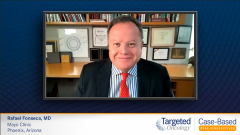
Treatment Armamentarium for Relapsed/Refractory Multiple Myeloma
Rafael Fonseca, MD, shares an overview of the treatment armamentarium for patients with relapsed/refractory multiple myeloma.
Episodes in this series

Transcript:
Rafael Fonseca, MD: There are plenty of options for the treatment of myeloma in the setting of relapsing disease and this has proven to be quite daunting as far as all selecting 1 of those optimal therapies. Fortunately, as time goes by and we’re getting the results of various clinical trials, the field is coalescing toward some common themes. For the early relapse, we’re finding out that the introduction of monoclonal antibodies is important, so we try to combine them with carfilzomib. This is inconvenient, and it’s not as good as when we’re able to treat patients with, say, daratumumab-lenalidomide. But the results of those clinical trials suggest the combination with carfilzomib is better. This is probably a reflection of the long-term exposure that many patients now have to lenalidomide in the frontline setting. Studies like CANDOR and IKEMA are positioning those regimens as optimal for that early relapse.
One has to consider duration of prior exposure and if the patient is on or off therapy. We even see some patients who, interestingly, are relapsing many years after they were treated in the past. Some patients were treated with regimens like CyBorD [cyclophosphamide, bortezomib, dexamethasone]. We know that for some of them, the treatment today is almost as if you’re treating them for the first time. There are quite a few options for those patients.
Once you go into the second relapse, things start getting a little more complicated. We have the agents that are described as novel. They include the combination of selinexor with bortezomib, and that’s how it’s FDA approved, although I use it quite a bit in combination with carfilzomib too. We also have belantamab, which is the BCMA-targeting ADC [antibody-drug conjugate] that can also be used in this patient population.
I’ll refer the audience to the ALGONQUIN clinical trial presented at ASH [American Society of Hematology Annual Meeting] in 2021 by Dr Suzanne Trudel. She presents belantamab in combination with pomalidomide and dexamethasone with a pretty high level of response. We’ve come quite rapidly to this scenario with all the T-cell engagers, whether they’re bispecific antibodies or the T cells themselves in the form of CAR [chimeric antigen receptor] T cells. They’re indicated for more advanced disease according to the package insert, but hopefully in very near future we’re going to see them playing a very important role in that second relapse.
For those in the audience who are wondering, “You’re telling me you do a transplant and then maintenance, and then you have, say, CANDOR and IKEMA or IKEMA for that first relapse. What do I have for later?” You mentioned belantamab and selinexor. Even if the patient was able to get that, we’re talking of median overall survival exceeding 10 years. We want our patients to get all the agents, but there’s a very important fraction of patients who undergo attrition by the various lines of therapy. Saving drugs for later is not a good idea because whatever the benefit is later, that has to be multiplied by the percentage of patients who remain in that line of therapy. In other words, when I present a study that says drug A plus B is better than drug A, everyone is happy. But a reasonable person would say, “You need to show me that drug A plus B is better than A followed by B.” That’s true, but it has to be empirically documented. The formula for that would be drug A plus B is better than A followed by 50% of B. That’s the attrition rate, and patients are not getting to that later line of therapy.
Transcript edited for clarity.









































